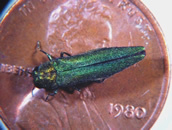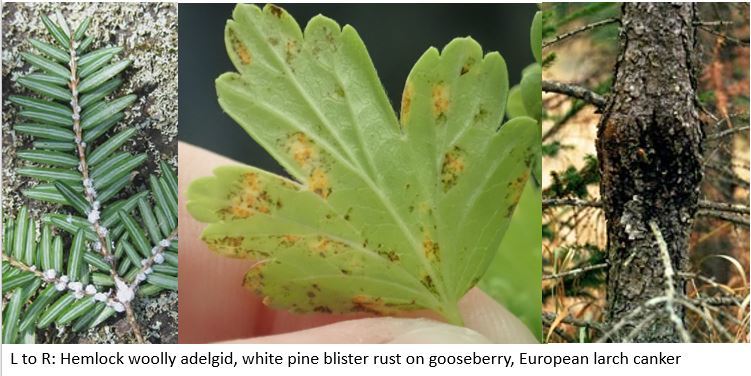Horticulture
In this issue:

MELeaf readers have educated eyes and can help us stay watchful for invasive pests like emerald ash borer (EAB). The earlier we can detect EAB presence in new areas the greater the chance for appropriate management to occur.
Here are three ways that you can work with the DACF to help us monitor for EAB or to educate your customers about this destructive, invasive pest:
-
Hang an EAB purple monitoring trap at your business or other properties that may have mature white, green or brown ash present. The trees should be very accessible from a road and in an area where the risk of vandalism is low. The traps will be hung and maintained by DACF staff. If you are interested, please contact horticulture@maine.gov.
-
Create a trap tree. To create a trap tree, an ash tree is girdled in May or early June. This slowly kills the tree, but it will remain alive through the growing season. Girdling stresses the tree, causing it to release volatile compounds that make it attractive to EAB that may be close by, but not detectable. Girdled trees are cut the following fall or early winter and sections are peeled to search for galleries and larvae. Visit the Maine Forest Service’s Trap Tree page for more details.
-
Distribute EAB awareness materials to your customers. We have brochures and rack cards. If you are interested in getting some of these materials, please contact bugwatch@maine.gov.
|
 We hope to slow the spread of this deadly insect and you and your employees can be our best allies. Movement of firewood is the highest risk pathway; reach out to customers, family and friends to discourage the movement of hardwood firewood.
More Information:
EAB in Maine including maps of the current quarantine areas
Watch the latest webinar about EAB in Maine from the Maine Forest Service
Invasive Trifecta, May 18-22: Emerald Ash Borer Awareness Week, Arbor Week and National Invasive Species Awareness Week
13 Ways to Participate, through May 23: Arbor Week, EAB Awareness Week and NISAW
This week is National Invasive Species Awareness Week and, as most of you know, in addition to the emerald ash borer regulations, Maine has several other quarantines to prevent the movement of invasive species that may affect your plant sales. You can help protect Maine’s forests and natural areas by taking these steps to comply with Maine’s plant health quarantines.
-
Source hemlock plants from hemlock woolly adelgid (HWA) free areas. This is required for businesses outside Maine’s HWA quarantine. However, with the expansion of the HWA quarantine area earlier this year, much of coastal Maine is now quarantined for this pest. In many parts of the quarantine area populations of HWA are low. To reduce the risk of introducing HWA to new areas or areas that are currently only lightly infested we encourage all hemlock sellers, even those inside the quarantine area, to source their hemlocks from HWA free locations. More Information on HWA Quarantine Boundaries and Importing Hemlocks to Maine
-
Do not grow or sell Ribes spp (currants and gooseberries). Currants and gooseberries are alternate hosts for white pine blister rust, which is a serious pest of white pine that kills young pine trees, interfering with forest regeneration and attacks mature trees reducing the value of the wood. Like many rusts WPBR needs an alternate host to complete its lifecycle, in this case currants or gooseberries. Ribes nigrum (black currant) is illegal to sell in all of Maine and all other Ribes species cannot be sold in most of Maine.
Ribes plants produce tasty fruit that make them desirable and we do occasionally find plants for sale at garden centers. In one incident last year we found gooseberry plants at a garden center that were showing obvious symptoms of WPBR (picture below). All the plants had to be destroyed.
-
Know if you are in the European Larch Canker (ELC) quarantine area. This quarantine prevents the movement of Larix spp and Pseudolarix spp (larch, tamarack) plants from certain parts of Hancock, Knox, Lincoln, Waldo and Washington Counties, the only areas in the United States where this disease is known to occur. If your nursery or garden center is in one of these towns and you sell larch, please contact horticulture@maine.gov to ensure compliance with this quarantine.
-
Be familiar with Maine’s invasive plant lists and don’t sell these problematic plants. Maine bans the sale of 33 invasive terrestrial plants. If you sell aquatic plants, Maine Department of Environmental Protection (DEP) bans the sale of 11 invasive aquatic plant species.

|